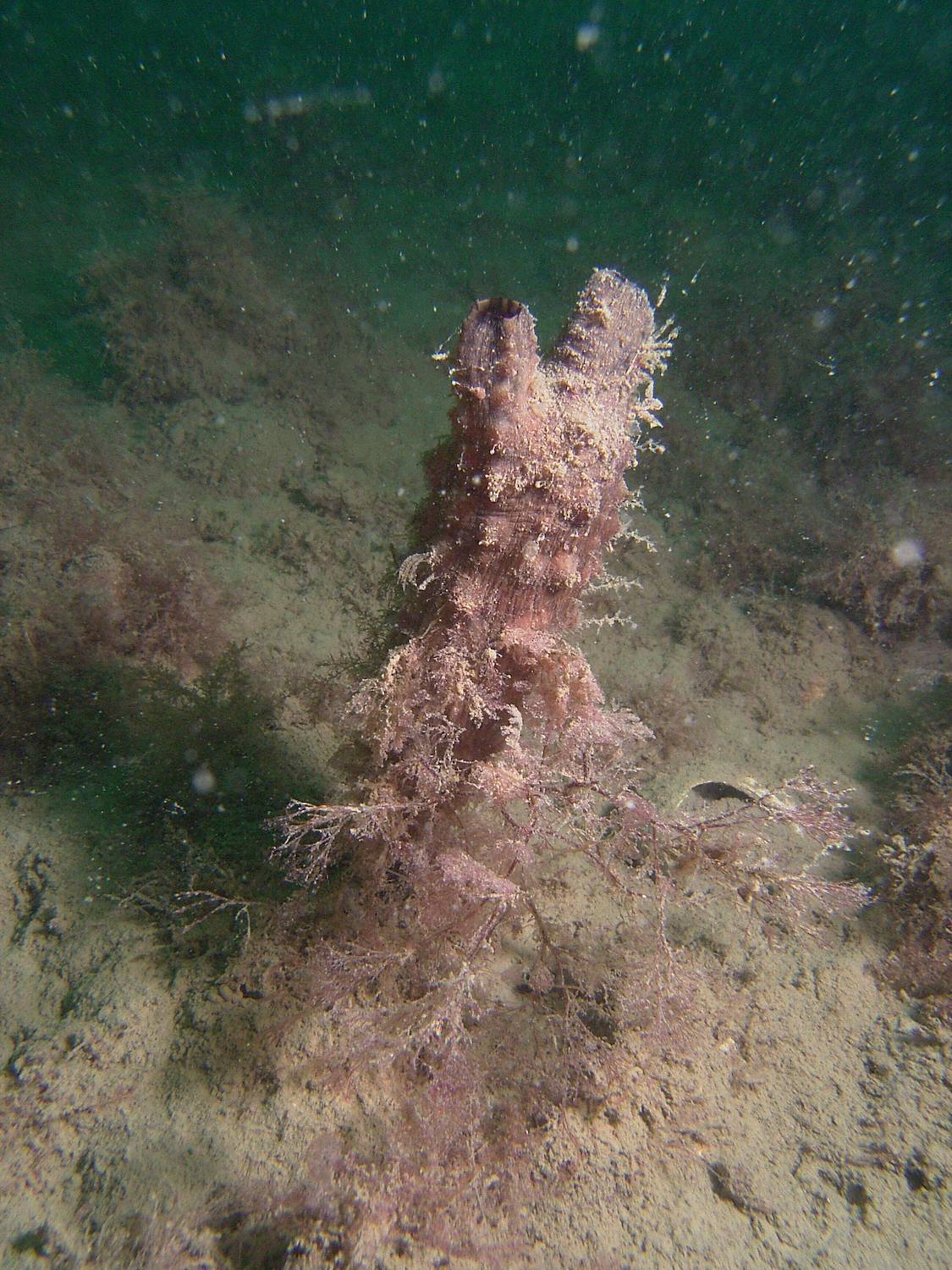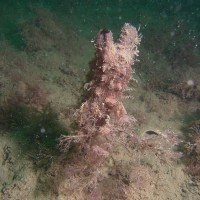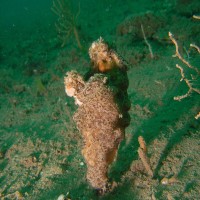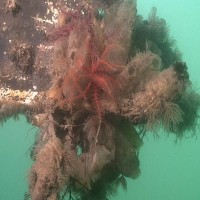
Leathery sea squirt - Styela clava
Expand and collapse the sections below by clicking on the title or + / - icons.
Short description of Styela clava, Leathery sea squirt
A brown, non-colonial (unitary or ‘solitary’) sea squirt up to 20 cm tall, attached by a small flat holdfast at the base of a narrow stalk, and with two siphons close together at the free end. The surface is tough and leathery, with folds and swellings. The siphons show dark brown stripes when open.
Impact summary: Styela clava, Leathery sea squirt
A large organism that can achieve high densities and cause fouling to ships. Not noted as a problem to aquaculture in GB, but a severe nuisance to long-line mussel farming in Prince Edward Island (eastern Canada) until replaced by other invasive ascidians. Outer tunic provides extensive settlement surface for other sessile species.
Habitat summary: Styela clava, Leathery sea squirt
Attached to solid surfaces in shallow water, especially in harbours and marinas but also on wrecks and natural rock bottoms.
Overview table
| Environment | Marine |
|---|---|
| Species status | Non-Native |
| Native range | Northwestern Pacific |
| Functional type | Filter-feeder |
| Status in England | Non-Native |
| Status in Scotland | Non-Native |
| Status in Wales | Non-Native |
| Location of first record | Plymouth |
| Date of first record | 1953 |
Origin
Native to NW Pacific: Japan, Korea, parts of coasts of Russian Federation and China. The introduction of this species to GB is probably from Korea.
First Record
Well-grown specimens were noted in 1953 in Plymouth Sound (Devon) and adjacent Lynher estuary, presumably arising from larval settlement in 1952.
Pathway and Method
Probably transported on of hull of warship returning from Korean War for repair or maintenance in naval dockyard in Plymouth, very close to sites of discovery (Second independent introduction to northern Denmark, confirmed by genetic differences, apparently with importation of Crassotrea gigas oysters from west coast of USA in 1970s).
Species Status
Very well established in GB, and present on Atlantic coast of Europe from northern Denmark to southern Portugal. Also introduced on both seaboards of North America, in Australia, and in New Zealand.
Dispersal Mechanisms
Natural dispersal potential apparently quite limited: sessile as adult; pelagic embryonic development for 12-15h following external fertilization, but hatched larva non-feeding, and motile phase accordingly relatively brief (12-24h), with only intermittent swimming. In marinas in SW England, genetic differentiation was detectable within some populations along 100m of pontoon, implying very limited natural (larval) dispersal. However, the genetic differentiation between marinas over 200km of coast was not related to geographical separation, suggesting periodic migration between distant sites, presumably involving human-mediated movement of the adult phase.
Reproduction
Hermaphroditic, releasing both eggs and sperm for external fertilization. Does not self-fertilize. Non-feeding ‘tadpole’ larva hatches after period of pelagic embryonic development. Post-metamorphic juvenile lacks stalk of larger adult.
Known Predators/Herbivores
Larval phase presumably vulnerable to predators of plankton. Young individuals in the sessile phase vulnerable to predation by gastropods, fish or starfish. Larger adults, protected by very tough tunic, have no known predators in Atlantic populations.
Resistant Stages
No resistant or resting stage in the life cycle, but adults can survive 2-3 days out of water.
Habitat Occupied in GB
Attached to solid surfaces in shallow water, especially in harbours and marinas but also on wrecks and natural rock bottoms.
Principally in harbours and marinas, from the Clyde (Scotland) around south coast of England and to the Humber. Scattered localities in Ireland, and on the Atlantic coast of Europe from northern Denmark to southern Portugal (Sines). Recently recorded from a single locality on the French Mediterranean coast. Also introduced on west (c. 1930) and east (1970) coast of North America, in Australia (1972) and New Zealand (first recorded 2005).
Environmental Impact
Styela clava is a relatively large organism that can reach high densities, sometimes being the dominant species in shallow sheltered habitats. The species might thus have a negative effect on the abundance and habitat occupancy of other shallow-water suspension feeding sessile invertebrates. However, it is not clear whether this would cause the local extinction of any species. The relatively small holdfast takes up little space, while the tunic covering the body is often heavily incrusted by other sessile species. The increased secondary space for encrustation and three-dimensional habitat complexity provided by S. clava can apparently enhance biodiversity estimated per unit area of primary substrate: after a year, panels in a Devon marina on which S. clava had been allowed to flourish showed a small but significant increase in per-panel diversity (not counting S. clava itself) compared to panels from which S. clava had been excluded by periodic weeding.
Health and Social Impact
None known.
Economic Impact
The species has been documented as a serious pest in long-line mussel farms in Prince-Edward Island, Canada, with reports of similar effects within the native range, in Japan. It can compete for food with mussels or oysters and partially smother them, and can foul ropes, buoys, moorings, ships etc. heavily.
Identification
Hayward, P.J. & Ryland, J.S. (1998) Cheilostomatous Bryozoa. Part 1, Aeteoidea – Cribrilinoidea. Syn Br Fauna NS 10, 366pp.
Marine Aliens II consortium. (2010) Identification guide for selected marine non-native species. Second Edition, available from: www.marlin.ac.uk/marine_aliens/latest_news.php
Biology, ecology, spread, vectors
Carlisle, D.B. (1954) Styela mammiculata n.sp., a new species of ascidian from the Plymouth area. Journal of the Marine Biological Association of the UK, 33, 329-334.
Darbyson, E A (2006) Local vectors of spread of the green crab (Carcinus maenas) and the clubbed tunicate (Styela clava) in the southern Gulf of St. Lawrence, Canada. Masters thesis, Dalhousie University (Canada). (Masters Abstracts International. Vol. 45, no. 01, 105pp.)
Dupont, L., Viard, F., Dowell, M.J., Wood, C. & Bishop J.D.D. (2009) Fine- and regional-scale genetic structure of the exotic ascidian Styela clava (Tunicata) in south-west England, 50 years after its introduction. Molecular Ecology, 18, 442-453. doi: 10.1111/j.1365-294X.2008.04045.x
Dupont, L., Viard, F., Davis, M. H., Nishikawa, T. &, Bishop, J. D. D. (2010) Pathways of spread of the introduced ascidian Styela clava (Tunicata) in Northern Europe, as revealed by microsatellite markers. Biological Invasions, 12, 2707-2721. doi 10.1007/s10530-009-9676-0
Lützen J (1999) Styela clava Herdman (Urochordata, Ascidiacea), a successful immigrant to North West Europe: ecology, propagation and chronology of spread. Helgol Meeresunters, 52, 383-391. www.dfo-mpo.gc.ca/Library/329953.pdf
Management and impact
Davis, M. & M. Davis (2009) Styela clava (Tunicata, Ascidiacea) - a new threat to the Mediterranean shellfish industry? Aquatic Invasions, 4, 283-289. doi 10.3391/ai.2009.4.1.29
General
Davis, M. & M. Davis (2009) Styela clava (Tunicata, Ascidiacea) - a new threat to the Mediterranean shellfish industry? Aquatic Invasions, 4, 283-289. doi 10.3391/ai.2009.4.1.29
Lützen J (1999) Styela clava Herdman (Urochordata, Ascidiacea), a successful immigrant to North West Europe: ecology, propagation and chronology of spread. Helgol Meeresunters, 52, 383-391. www.dfo-mpo.gc.ca/Library/329953.pdf
Spotted this species?
Distribution map
View the Distribution map for Leathery sea squirt, Styela clava from NBN Atlas
ID Sheet
ID Sheet for Styela clava . See a full list of non-native species ID Sheets.



